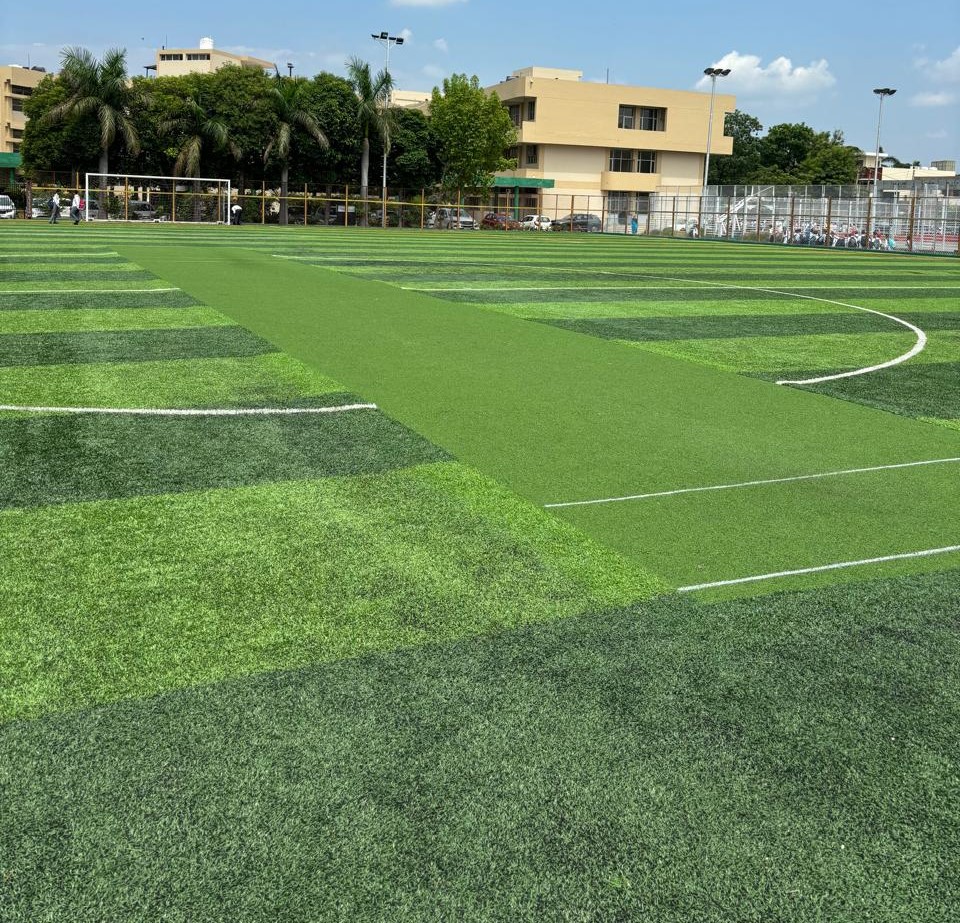
Artificial grass is a surface that consists primarily of synthetic fibers, a backing, and a coating that resembles natural grass in appearance.
They are ideal for community sports and for schools and public parks. Synthetic turf is now being used for full pitches, training areas, mini football, and futsal centers with advanced artificial grass turf. Artificial turf is widely used not only in various outdoor sports fields such as soccer, hockey, rugby, tennis, and golf but also in residential and commercial areas.
Artificial grass comes in many varieties for various sports, depending upon the use. Research is required before deciding to use an artificial turf for your facility depending on factors like what kind of space you want to use it for and your budget. Different brands and models of artificial turfs are suitable for different uses. There are various factors to look out for when choosing an artificial grass like density, pile height, face weight, thatch, infill, backing, blade height, and more.

We've always believed in looking after our students and facilitating an overall development of their characters. There is where sport comes into play and the right sporting infrastructure is of utmost importance to say the least. We would like to thank Gallant Sports from the bottom of our hearts for doing such a wonderful job of transforming our vision into reality. The Product which we decided to go ahead with is called Superb and truth be told, we haven't been disappointed. We look forward to working with Gallant Sports in the future.
Brother Varghese
St. George’s College, Mussoorie
We are happy that we contracted Gallant Sports & Infra Ltd, for the installation of multiple indoor and outdoor sports facilities at our school premises. The Gallant Sports team created the plan and oversaw the completion of one full size football field, cricket nets, basketball and badminton courts, skating rink and a children's play area covering a total area of 1,00,000 sq.ft. with superior quality products that our students are thoroughly enjoying using. The project was well co-ordinated including the civil works required and implemented in a timely manner. The client servicing team was always hands on and available to address our queries and concerns throughout the duration of the project.We highly recommend Gallant Sports & Infra Ltd. for similar projects and wish them the best in the future.
Ms. Poonam Gupta
Principal, BGS International School
At Shivalik School, we believe sports play a vital role in shaping character and nurturing growth. Gallant Sports has completely transformed our sports infrastructure with exceptional football, hockey, and basketball courts, setting a new standard for excellence. Their professionalism, meticulous attention to detail, and unwavering commitment to quality are truly outstanding.
The new facilities have sparked immense excitement among our students, who are thoroughly enjoying every moment of play and practice. Gallant Sports has been a trusted partner in bringing our vision to life, and we highly recommend their world-class sports solutions to anyone looking to inspire greatness through sports.
Mr. BS Bedi
Shivalik School, Chandigarh
Gallant Sports has infused a new spirit of energy and excellence at Atlantis School with their outstanding multi-sports facilities. From basketball and football to volleyball, kho-kho, and a professional running track, every element has been meticulously designed to inspire and elevate student performance.
What truly sets Gallant Sports apart is their seamless coordination, timely delivery, and unwavering commitment to quality. Their civil team worked in perfect harmony with ours, ensuring flawless execution and clear communication throughout the project. We are proud to have partnered with Gallant Sports, as our students now enjoy world-class facilities that motivate them to excel, compete, and achieve new milestones.
Mr. Vasu
Atlantis School, Tirupati
At Nagarvala School, we are committed to providing an environment where our students can thrive in all aspects of life, and sports play an integral role in that journey. Gallant Sports has truly elevated our campus with state-of-the-art facilities that have brought a new vibrancy to our school.
Their team’s expertise and attention to detail were evident throughout the entire process, ensuring that every aspect of the project was executed to perfection. We are grateful to Gallant Sports for helping us create a space that will nurture talent, inspire teamwork, and encourage a lifelong love for physical activity.
Mr. Dalal
Principal, Nagarvala School, Pune
Transforming sports infrastructure into a world-class experience was pivotal for Sparsh Global School, and Gallant Sports exceeded our expectations. More than a service provider, they became a true partner, sharing our vision and delivering it with precision and care.
From the outset, their team meticulously understood our needs, crafting a dynamic sports complex tailored for excellence. The result is extraordinary: a football field with a race track, along with padel tennis, basketball, and volleyball courts—all designed to inspire and energize. The passion and enthusiasm in our students today stand as a testament to the transformative impact of these remarkable facilities. .
Mr. Kedia
Owner, Sparsh Global School, Greater Noida
Density, measured as stitch count, affects the resilience and natural look of the grass. Higher density is generally better quality.
Infill helps maintain fiber alignment, stability, and a lifelike feel, preventing matting and providing cushioning.
Backing, both primary and secondary, contributes to dimensional stability and durability. A higher back weight is preferable for high-traffic areas.
Let us call you back!